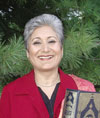
Guest Editorial
Building a global interfaith community
By Raheel Raza
January/February 2007
Return to Table of Contents
Print Article
In November 2006, when Pope Benedict visited Turkey, he said, "With the help of God, we must find the way of peace together, for the good of humanity." These words, as a global vision for interfaith relations, are urgently needed today and bode well for people and institutions building bridges of understanding between faith communities.
We live in times when the world is involved in violence perpetuated in the name of faith. World renowned scholar of religions Karen Armstrong writes, "Every time a violent action or an intolerant word is spoken, the world becomes a worse place and the virus of evil and hatred spreads. But every time any single believer reaches out to others in compassion and sympathy, the world improves a bit."
Compassion and understanding are the keystones of interfaith dialogue. For this to happen, we as humans have to respect each other regardless of which tradition we follow.
How do we build mutual respect? In these challenging and too often troubled times, we need new perspectives and models so that we can find humane answers to the challenges of globalization, based on a deep respect for the diversity of cultures and religions in our world community. There is a desperate need for new and practical ways of reintroducing spirituality, ethics and faith into the international debate on globalization, and the local consultation on inclusivity and social reform. This work has to be done at a grassroots level and build up to a global reality.
Religious inclusivity only happens when faith communities and their leaders join hands with politicians to forge an understanding that through partnerships in a pluralistic society we can encourage socially beneficial peace, nurture friendly behavior and ecumenical decisions.
To be sure, many people are already committing themselves to these goals. For example the work of the Scarboro Missions Interfaith Desk, their Golden Rule Poster and their openness to others. This is the kind of model that is needed for an international global interfaith project. A model that stresses on similarities rather than differences, and reflects that there is unity in diversity.
But a deeper change of consciousness is also needed. Religious inclusivity has to be promoted from the pulpit. In places of worship, whether they are churches, temples, mosques or synagogues, the message should be one of pluralism and respect.
This will help us gain consideration for each other and work on the basis of common visions, ideals, values, aims and criteria. This will also help us eliminate the seed of racism, which is ignorance. We have to understand that we have the power and need the incentive to move beyond mere tolerance towards accepting all cultures and religions.
However, it is important to remember that unity does not mean uniformity. Whether we accept it or not, diversity is a blessing from God who created humanity into different nations and tribes so that we may know one another.
The Persian poet Saadi phrases the challenge of humanity in the following words:
Human beings are like
members of one body
Created from one and the
same essence
When one member feels pain, The rest are distraught
You – unmoved by the
suffering of others
Are unworthy of the name human.
Raheel Raza is a Muslim author, media commentator and interfaith activist. She has been involved in a number of the Scarboro Missions interfaith events.
Return to Table of Contents
Print Article